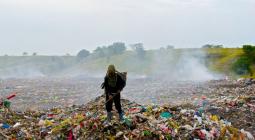Burning rubbish to create energy could end landfills. But some worry where Australia’s new path is leading
Some conservationists believe the ‘incineration industry’ is trying to gain a foothold in Australia and say the trend will end up damaging the environment
Australia’s first major waste-to-energy power plant has begun accepting rubbish, marking the start of a contentious nationwide shift towards burning household refuse to generate electricity.
At least 10 developments are under way across the country, sparking concern from some conservationists who argue the trend will be environmentally damaging and at odds with plans to develop a circular economy.
Local councils have started sending truckloads of garbage to Kwinana Energy Recovery facility, south of Perth, as the country’s first commercial-scale project heads towards full-scale operation.
The Kwinana plant is designed to burn up to 460,000 tonnes of non-recyclable waste annually – about a quarter of the amount Perth sends to landfill.
Another 300,000-tonne-a-year generator is under construction just down the road at East Rockingham. Four licences to build major waste-to-energy facilities have been issued in Victoria and there are proposals in New South Wales, Queensland and South Australia. Combined, the projects in development would have the capacity to incinerate 2m tonnes of waste a year – a quarter of what Australian households throw away.
Waste-to-energy has experienced a surge of interest in Australia as landfills near capacity. Proponents say it could mean an end to landfill, and that air pollution and ash can be managed under existing environmental regulations.
But not everyone is convinced. The environmental group Zero Waste Australia calls the approach “the most polluting and expensive way to generate energy and manage waste” and has raised concerns about the environmental and health consequences.
Jane Bremmer, the group’s campaign coordinator, says the number of waste-to-energy proposals is “gobsmacking”, and a sign the “incineration industry” is trying to gain a foothold in Australia as it was being pushed out of Europe, where some plants are being decommissioned.
Better than landfill?
The City of Gosnells, a council with 130,000 residents south-east of Perth, is among 10 local governments sending waste to Kwinana to be burnt.
The city’s mayor, Terresa Lynes, says the change comes after a decade of planning, and a long-term contract with the facility shields ratepayers from increasing and unpredictable landfill levies.
“This is the end of landfill for the City of Gosnells,” she says, with power produced an added benefit. The council is focusing on recycling and green waste too, she says, emphasising waste-to-energy is only “part of the solution”.
In recent years, circular economy and waste policies in Western Australia, Victoria, NSW, Queensland, South Australia and Tasmania have preferred waste to energy over landfill for disposing of non-recyclable waste. However, the practice is prohibited in the ACT.
Jennifer Macklin, a circular economy researcher with the Monash Sustainable Development Institute, says the underlying principle of a circular economy is to keep materials circulating at their highest value for as long as possible, for example through repair and reuse.
The waste-to-energy process – which typically involves burning non-recyclable waste in large furnaces at high temperatures to generate electricity or heat – is the “lowest value way of circulating” because the value in the materials is lost, she says.
Using the energy “definitely offered a small benefit over landfill”, Macklin says, but poses a risk to higher-value reuse and recycling efforts.
She says evidence from other countries indicates recycling rates can plateau after the introduction of waste-to-energy plants, partly because once the infrastructure is built “you’re locked in feeding it”.
The arrival of waste to energy can also dampen motivation and participation in reuse and recycling at the household, organisation and even government level, she says.
The NSW chief scientist, Prof Hugh Durrant-Whyte, provided independent advice on the technology to the NSW government in 2020. He said waste to energy was well established in Europe, but as some countries improved their waste reduction, sorting, reuse and recycling efforts, some facilities were being decommissioned. “They’re shutting them down, not because of air emissions but because they no longer have the waste to actually burn.”
Across Europe, there are about 500 waste-to-energy plants, but circular economy efforts have led some countries to reduce their reliance on the technology. Denmark, for example, plans to reduce waste incineration capacity by 30% between 2020 and 2030.
Is power from plastic renewable?
Gayle Sloan, CEO of the Waste Management and Resource Recovery Association, says waste combustion is better for the climate than creating methane in landfills. “We shouldn’t be throwing things in the ground. If we can’t recover it, we should be using it for energy,” she says.
Government policies support the approach as an option for residual waste – the materials left over after recyclable, green and food wastes have been removed. In many states, that’s the “red bin” waste, containing soft plastics, nappies and synthetic textiles.
In Australia, energy produced by burning plastics is not renewable even though projects promote their power as clean and green.
Acciona, owner of the Kwinana facility, says converting waste into energy “addresses both the waste crisis and the need for clean, reliable power in WA”.
The WA facilities – Kwinana and East Rockingham – both received funding from the Australian Renewable Energy Agency (Arena).
Cover photo: The Kwinana Energy Recovery plant, south of Perth, is designed to burn up to 460,000 tonnes of non-recyclable waste annually – about a quarter of the amount Perth sends to landfill. Photograph: Acciona





